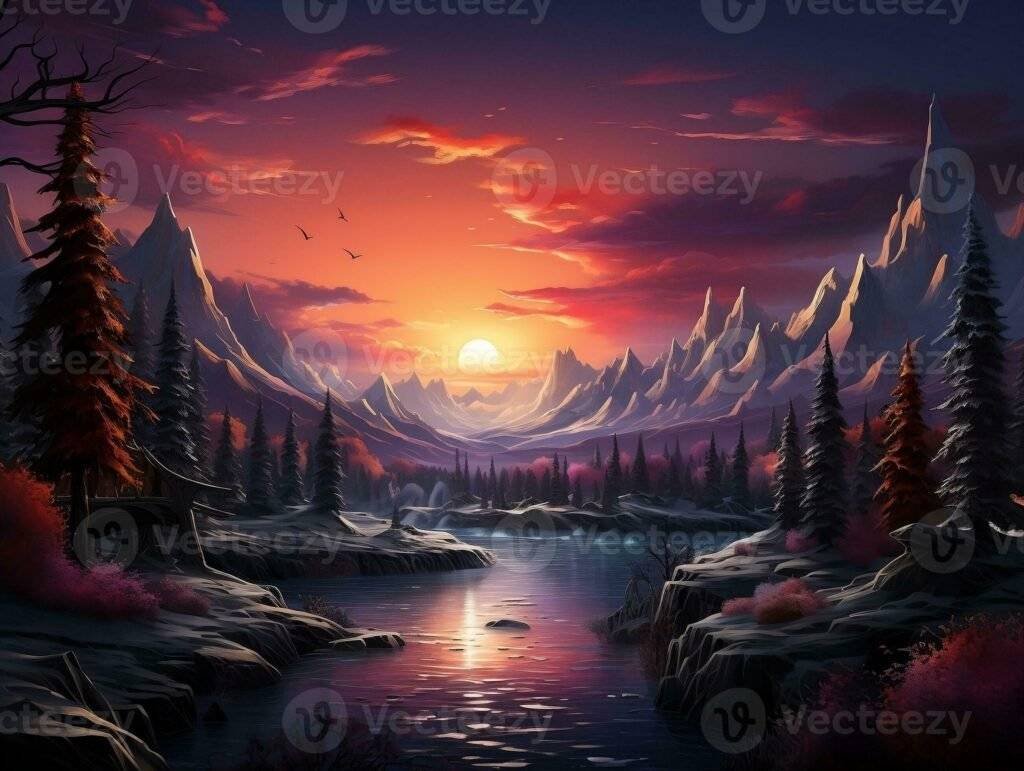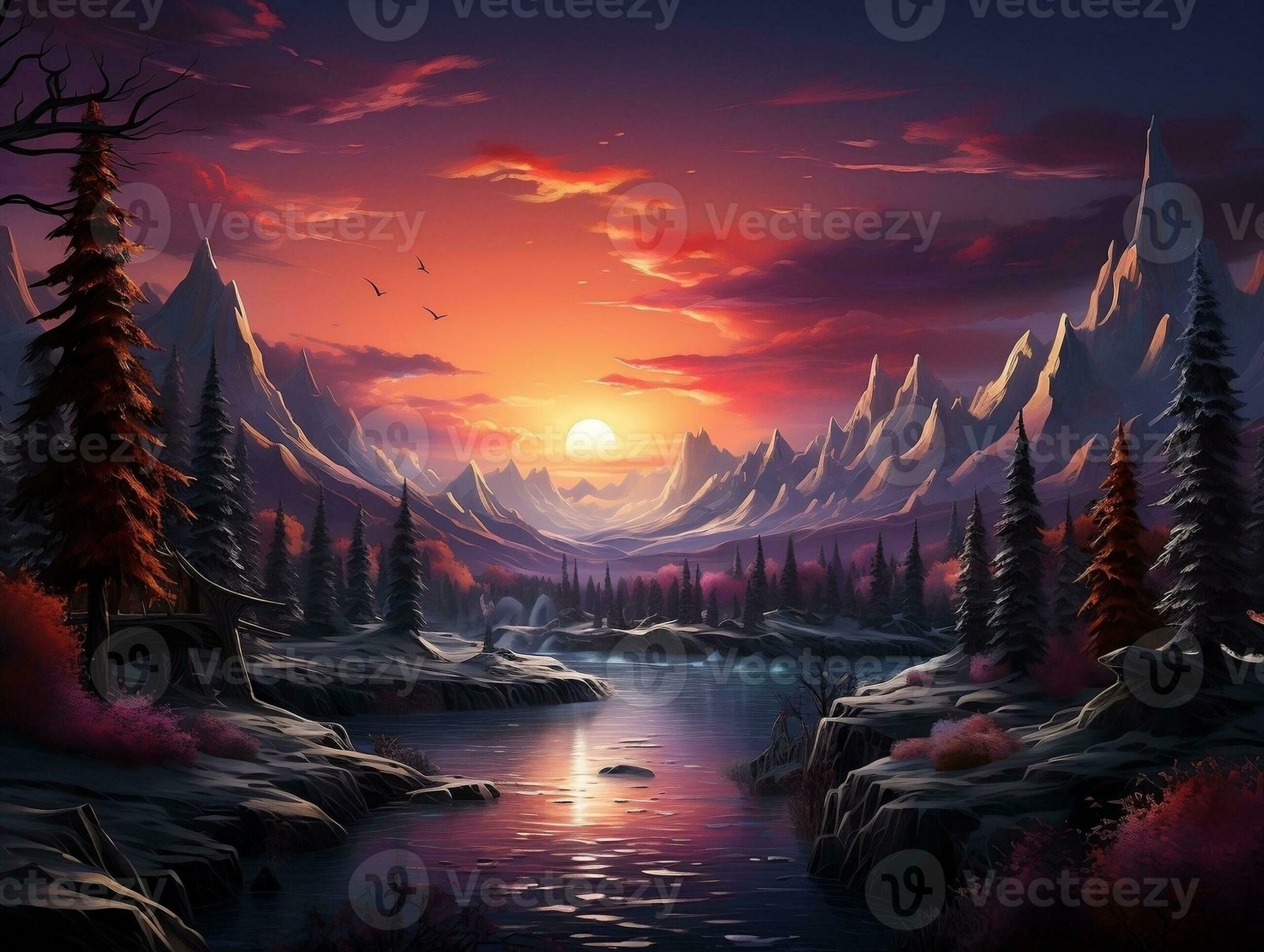
Landscape painting captures nature’s breathtaking beauty on canvas through vibrant meadows to dramatic mountains. As an artistic genre, this form allows artists to freely express their individual creativity while communicating personal viewpoints and personal views.
From ancient times on, artists depicted landscapes as backdrops for religious or historical scenes. Yet it wasn’t until Renaissance period that landscape painting truly gained recognition as its own genre.
Composition
Composition is one of the key aspects of landscape painting. A poor composition can ruin even a well-executed drawing; conversely, good composition can add strength and vibrancy to an otherwise static piece. There are various components involved with strong landscape compositions; perhaps one of the most vital is placement of the horizon line.
Although Ancient and Classical paintings featured scenes of natural scenery, landscape painting as an independent art form did not come about until Renaissance in the 16th century. Prior to then, landscapes had often been included as part of other paintings depicting historical or religious themes.
Dutch artists such as Jacob van Ruisdael and Aelbert Cuyp were heavily influenced by Italian landscape painters such as Nicolas Poussin and Claude Lorrain during the 17th century, creating realistic landscape paintings which had metaphorical associations for its elements, providing backdrops for biblical or mythological stories. These artists endeavored to elevate this genre through symbolic interpretation.
Modern 20th-century landscape painting movements include Precisionism, an idiom developed by Charles Demuth; American Scene Painting and Regionalism (both focused on urban landscapes with industrial buildings); Graham Sutherland’s Welsh mountain scenes from the 1930s have an almost poetical yet sometimes dystopic quality; other contemporary landscape painters have experimented with new concepts and styles including Photorealism.
Compositional principles of landscape painting are invaluable regardless of your skill level, from beginning painters to experienced ones. Learning them will help prevent common blunders such as placing too much detail in the foreground or placing your focal point too high/low on the picture plane. Furthermore, you can utilize perspective to add depth in your paintings, as well as play around with light effects on various parts of a scene for dramatic or moody effects.
Light
Light is an integral component of landscape painting; its role can range from emphasizing details and casting shadows, to altering a scene’s overall atmosphere and mood. A softly lit morning might suggest rejuvenation while harsh midday sun may spark drama and tension.
Artists use lighting to create depth with their paintings. To do this, they typically paint the background first before adding more intricate details to middle ground and foreground layers with additional color and detail. It is key that artists strike a balance between capturing all details while simplifying certain elements so as not to overwhelm viewers with visual clutter.
Framing and leading lines are two essential techniques when painting landscapes. These elements help guide the viewer’s eye from one section of a painting to the next, leading them to its focal point. A river or path may serve as an inviting border that draws them in; similarly, mountains and trees serve as natural frames that draw attention to dramatic features of a scene.
Texture in painting can evoke the beauty of nature. An experienced painter can use impasto to convey thick streams or lakes in nature; adding dimension by inviting viewers to almost touch their canvas painting, providing them with both tactile and visual experiences from viewing a painting.
Color
Earth’s natural beauty provides visual artists with endless creative inspiration. Landscape paintings capture its grandiose beauty – whether its towering mountains of the Himalayas, rolling hills in England or lush forests in Brazil – with skillful use of color that enhances depth and dimension, conveys mood and atmosphere and generates movement within viewers eyes.
Landscape painters often think about color in terms of seasons when considering its use in their paintings. From cool blues and greens of springtime to the vibrant yellows and reds of autumn, seasonal hues can help evoke a sense of place within your painting, drawing the viewer closer to it while giving it more vibrancy and life. Color can also serve to highlight specific elements within it by creating focal points that draw viewer’s attention towards specific parts of the scene.
Harmonious color selection is another essential aspect of landscape painting, including selecting hues that complement one another on either end of the color wheel or through their tonal compatibility. For instance, complementary hues (such as orange and purple) could create dramatic contrast or analogous colors (such as greens and browns) may create an uplifting, cohesive atmosphere in your piece.
Practice is the key to understanding landscape color theory. Bring your sketchbook on nature walks or hiking trips and experiment with various color combinations; draw multiple versions of one scene using different palettes and observe how they alter its mood and emotion. Also take advantage of plein air painting opportunities in outdoor settings so that you can directly observe how light and weather impact various scenes’ hues as well as how they interact.
Texture
Landscape painting is an expansive art form, offering artists unending creative potential and exploration. By employing different techniques and elements, artists can craft landscapes that not only encapsulate nature’s beauty, but also stir emotions within viewers.
Composition is of vital importance when creating landscape paintings, as it helps establish balance and harmony within a scene. This can be accomplished using traditional composition rules such as thirds or golden ratio to find balance within your painting and draw the eye into it. Framing elements such as trees or mountains can help guide viewers’ gazes and draw them towards its main subject matter.
Light is an integral component of landscape paintings, as it conveys various emotions. Direction, intensity and color of light can all be used to emphasize various parts of a scene and elicit particular emotions from viewers. Weather elements are also often included as an added layer to add depth and drama; foggy scenes may elicit feelings of mystery or melancholy while sunny landscapes elicit happiness and warmth.
Improving the realism and charm of your landscapes by adding texture is an effective way to create more captivating environments. This can be accomplished using various brushwork techniques, from drybrushing to impasto. A thick application of paint may give the surface a gritty surface that conveys rough rock surfaces or coarse grass textures; other methods, such as blending or glazing may create more refined effects that add depth.
As with all forms of art, practice is key to becoming a great landscape painter. Dedicating time to planning out your composition, sketching ideas and exploring color palettes before embarking on painting can help avoid costly errors later on. Furthermore, studying masterpieces from different eras will show you how techniques have developed through time while providing inspiration for creating your own style.
Perspective
Landscape paintings can be an intricate endeavor, but understanding perspective will help you create convincing depth and scale in your artwork. For instance, when depicting snow-capped mountains with numerous peaks, paying careful attention to their height in relation to one another and maintaining an balanced composition is paramount for successful mountain paintings. When using linear and atmospheric perspectives you can achieve realistic depth while keeping a pleasing composition.
Landscape artists can add another dramatic dimension to their artwork by employing stacked perspective techniques. This technique allows artists to draw in backgrounds first and then layer a sky over it for a more realistic effect of light and color; clouds drawn with one-point perspective grids can have sky layered over them for natural-looking cloud shapes that feel as though they’re floating through space.
Landscape painters should never shy away from exploring different viewpoints and angles when creating images. Get down low, or find an elevated spot, to add an unusual perspective to your images. Also experimenting with wide-angle lenses or filters may give more dramatic shots or reveal details that would otherwise go undetected from a conventional angle.
Landscape paintings were once used primarily as backdrops for religious and mythological scenes, until landscape painting gained widespread acceptance as an art form during the Renaissance. Since then, this form of artistic expression has come to capture nature’s beauty while providing inspiration to many artists such as photographers and writers today.

